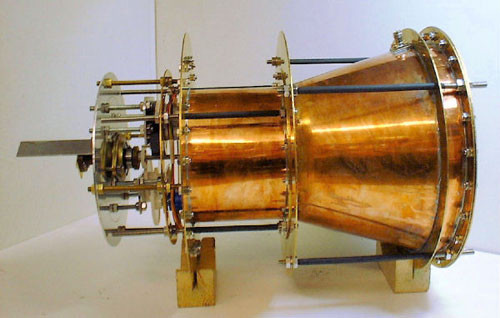EmDrive: AIAA confirms release date of controversial Nasa Eagleworks space propulsion paper
American Institute of Aeronautics and Astronautics did accept the Eagleworks electromagnetic propulsion paper.
The American Institute of Aeronautics and Astronautics (AIAA) has ended days of speculation by confirming it has indeed accepted a paper on the controversial space propulsion technology EmDrive, signalling that the Nasa Eagleworks paper has passed peer review.
- [UPDATE - 14:06 BST, 5 August 2016] EmDrive: Guido Fetta sending his Cannae Drive into space on a satellite to see if it works
An AIAA spokesperson told IBTimes UK that the paper on electromagnetic propulsion will be published in the AIAA Journal of Propulsion and Power in December 2016, but declined to reveal any further details as it is not part of the institute's policy to discuss peer-reviewed papers prior to publication.
The internet was set alight on 30 August when independent scientist and EmDrive skeptic Dr José Rodal posted on the Nasa Spaceflight forum – in a now-deleted comment – that the new paper will be entitled "Measurement of Impulsive Thrust from a Closed Radio Frequency Cavity in Vacuum" and is authored by "Harold White, Paul March, Lawrence, Vera, Sylvester, Brady and Bailey".
The post also included a line of text that was believed to be from the paper's abstract, which read: "Thrust data in mode shape TM212 at less than 810<sup>6 Torr environment, from forward, reverse and null tests suggests that the system is consistently performing with a thrust to power ratio of 1.2 +/- 0.1 mN/Kw ()".

How the EmDrive works
The EmDrive is the invention of British scientist Roger Shawyer, who proposed in 1999 that based on the theory of special relativity, electricity converted into microwaves and fired within a closed cone-shaped cavity causes the microwave particles to exert more force on the flat surface at the large end of the cone (i.e. there is less combined particle momentum at the narrow end due to a reduction in group particle velocity), thereby generating thrust.
His critics say that according to the law of conservation of momentum, his theory cannot work as in order for a thruster to gain momentum in one direction, a propellant must be expelled in the opposite direction, and the EmDrive is a closed system.
However, Shawyer claims that following fundamental physics involving the theory of special relativity, the EmDrive does in fact preserve the law of conservation of momentum and energy.
The AIAA is one of the world's largest technical societies dedicated to aerospace innovations. It is made up of over 30,000 engineers and scientists from 88 countries and hosts a collection of 140,000 technical papers, as well as developing and maintaining industry standards and advocating on policy issues.
There has been a great deal of debate over whether the EmDrive works, and many academics in the international space community continue to believe that it is complete nonsense, because the technology violates the law of conservation of momentum, and hence our understanding of physics. Ergo, it is a big deal for a major peer-reviewed journal to agree to publish research on this topic.
The team behind the paper is a group of researchers from Nasa Eagleworks, a sort of "moonshot" experimental laboratory for investigating fringe theories in advanced propulsion physics. EmDrive enthusiasts are excited by Eagleworks' involvement, although the US space agency has yet to officially validate the technology, with some believing it never will.
Either way, the British engineer/scientist Roger Shawyer, who invented the concept in 1999, does not really care if anyone validates his work, as he is already working with an unnamed UK aerospace company to develop the second generation of EmDrive, which will produce thrust that is many orders of magnitude greater than the thrust observed by Eagleworks or any other laboratory.
© Copyright IBTimes 2025. All rights reserved.






















